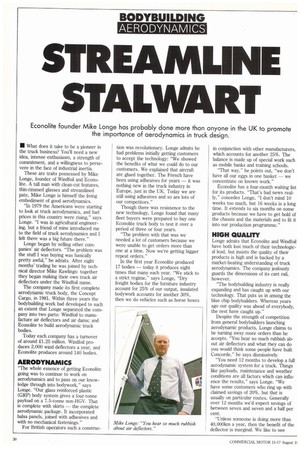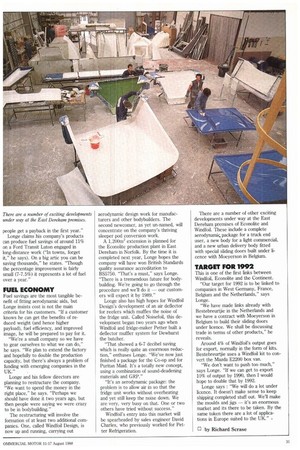STREAMLINE STALWART
Page 28

Page 29

If you've noticed an error in this article please click here to report it so we can fix it.
Econolite founder Mike Longe has probably done more than anyone in the UK to promote the importance of aerodynamics in truck design.
• What does it take to be a pioneer in the truck business? You'll need a new idea, intense enthusiasm, a strength of commitment, and a willingness to persevere in the face of industrial inertia.
These are traits possessed by Mike Longe, founder of Windfoil and Econolite. A tall man with clean-cut features, thin-rimmed glasses and streamlined pate, Mike Longe is himself the living embodiment of good aerodynamics.
"In 1979 the Americans were starting to look at truck aerodynamics, and fuel prices in this country were rising," says Longe. "I was in agricultural engineering, but a friend of mine introduced me to the field of truck aerodynamics and I felt there was a big future there."
Longe began by selling other companies' air deflectors. "The problem was the stuff I was buying was basically pretty awful," he admits. After eight months' trading he was joined by technical director Mike Rawlings: together they began making their own truck air deflectors under the Windfoil name.
The company made its first complete aerodynamic truck body, the Concept Cargo, in 1981. Within three years the bodybuilding work had developed to such an extent that Longe separated the company into two parts: Windfoil to manufacture air deflectors and air dams; and Econolite to build aerodynamic truck bodies.
Today each company has a turnover of around £1.25 million. Windfoil produces 2,000 wind deflectors a year, and Econolite produces around 140 bodies.
AERODYNAMICS
"The whole essence of getting Econolite going was to continue to work on aerodynamics and to pass on our knowledge through into bodywork," says Longe. "Our glass reinforced plastic (GRP) body system gives a four-tonne payload on a 7.5-tonne non-HGV. That is complete with skirts — the complete aerodynamic package. It incorporated balsa panels, joined with adhesives and with no mechanical fastenings."
For British operators such a construc tion was revolutionary. Longe admits he had problems initially getting customers to accept the technology: "We showed the benefits of what we could do to our customers. We explained that aircraft are glued together. The French have been using adhesives for years — it was nothing new in the truck industry in Europe, just in the UK. Today we are still using adhesives and so are lots of our competitors."
Though there was resistence to the new technology, Longe found that many fleet buyers were prepared to buy one Econolite truck body to test it over a period of three or four years.
"The problem with that was we needed a lot of customers because we were unable to get orders more than one at a time. Now we're getting bigger repeat orders."
In the first year Econolite produced 17 bodies — today it produces eight times that many each year. "We stick to a strict regime," says Lange, "Dry freight bodies for the furniture industry account for 25% of our output, insulated bodywork accounts for another 30%, then we do vehicles such as horse boxes in conjunction with other manufacturers, which accounts for another 25%. The balance is made up of special work such as mobile banks and training schools.
"That way," he points out, "we don't have all our eggs in one basket — we concentrate on known work."
Econolite has a four-month waiting list for its products. "That's bad news really," concedes Longe, "I don't mind 10 weeks too much, but 16 weeks is a long time. It extends to six months on some products because we have to get hold of the chassis and the materials and to fit it into our production programme."
NIGH QUALITY
Longe admits that Econolite and Windfoil have both lost much of their technological lead, but insists the quality of their products is high and is backed by a market-beating understanding of truck aerodynamics. The company jealously guards the dimensions of its cant rail, however.
"The bodybuilding industry is really expanding and has caught up with our technology. That puts us in among the blue chip bodybuilders. Whereas years ago our quality was ahead of everybody, the rest have caught up."
Despite the strength of competition from general bodybuilders launching aerodynamic products, Longe claims to be turning away more orders than he accepts. "You hear so much rubbish about air deflectors and what they can do you would think some people have built Concorde," he says dismissively.
"You need 12 months to develop a full aerodynamic system for a truck. Things like payloads, maintenance and weather conditions are all factors which can influence the results," says Longe. "We have some customers who ring up with claimed savings of 20%, but that is usually on particular routes. Generally over 12 months we'd expect savings of between seven and seven and a half per cent.
"Unless someone is doing more than 40,000km a year, then the benefit of the deflector is marginal. We like to see people get a payback in the first year."
Longe claims his company's products can produce fuel savings of around 11% on a Ford Transit Luton engaged in long-distance work ("In towns, forget it," he says). On a big artic you can be saving thousands," he states. "Though the percentage improvement is fairly small (7-7.5%) it represents a lot of fuel over a year."
FUEL ECONOMY
Fuel savings are the most tangible benefit of fitting aerodynamic aids, but Longe insists cost is not the main criteria for his customers. "If a customer knows he can get the benefits of reduced weight (and hence higher payload), fuel efficiency, and improved image, he will be prepared to pay for it.
"We're a small company so we have to gear ourselves to what we can do," he says. "We plan to extend the factory and hopefully to double the production capacity, but there's always a problem of funding with emerging companies in the UK."
Longe and his fellow directors are planning to restructure the company. "We want to spend the money in the right place," he says. "Perhaps we should have done it two years ago, but then people were saying we were crazy to be in bodybuilding."
The restructuring will involve the formation of at least two additional companies. One, called Windfoil Design, is now up and running, carrying out aerodynamic design work for manufacturers and other bodybuilders. The second newcomer, as yet un-named, will concentrate on the company's thriving sleeper pod conversion work.
A 1.200m2 extension is planned for the Econolite production plant in East Dereham in Norfolk. By the time it is completed next year, Longe hopes the company will have won British Standards quality assurance accreditation to BS5750. "That's a must," says Longe. "There is a tremendous future for bodybuilding. We're going to go through the procedure and we'll do it — our customers will expect it by 1989."
Longe also has high hopes for Windfoil Design's development of an air deflector for reefers which muffles the noise of the fridge unit. Called Noisefoil, this development began two years ago when Windfoil and fridge-maker Petter built a deflector muffler system for Dewhurst the butcher.
"That showed a 6-7 decibel saving which is really quite an enormous reduction," enthuses Lunge. "We've now just finished a package for the Co-op and for Puritan Maid. It's a totally new concept, using a combination of sound-deadening materials and GRP."
"It's an aerodynamic package: the problem is to allow air in so that the fridge unit works without overheating and yet still keep the noise down. We are very, very busy on that. One or two others have tried without success."
Windfoil's entry into this market will be spearheaded by sales engineer David Charles, who previously worked for Fetter Refrigeration. There are a number of other exciting developments under way at the East Dereham premises of Econolite and Windfoil. These include a complete aerodynamic package for a truck end user, a new body for a light commercial, and a new urban delivery body fitted with special sliding doors built under licence with Moeyerson in Belgium.
TARGET FOR 1992
This is one of the first links between Windfoil, Econolite and the Continent.
"Our target for 1992 is to be linked to companies in West Germany, France, Belgium and the Netherlands," says Longe.
"We have made links already with Bestebreurtjie in the Netherlands and we have a contract with Moeyerson in Belgium to build their sliding doors under licence. We shall be discussing trade in terms of other products," he reveals.
Around 4% of Windfoil's output goes for export, normally in the form of kits. Bestebreurtlie uses a Windfoil kit to convert the Mazda E2200 box van.
"We don't want to push too much," says Longe. "If we can get to export 10% of output by 1990, then I would hope to double that by 1992.
Longe says : "We will do a lot under licence. It doesn't make sense to keep shipping completed stuff out. We'll make the moulds and jigs — it's an enormous market and its there to be taken. By the same token there are a lot of applications in Europe suited to the UK."
0 by Richard Scrase












































